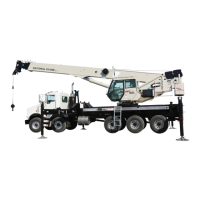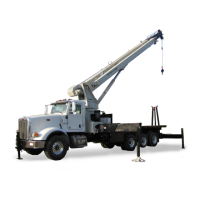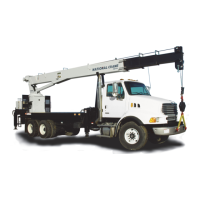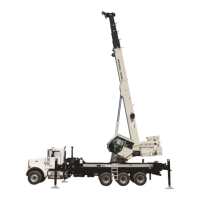3-18 Published 4-23-2018 Control # 239-11
OPERATING CONTROLS & PROCEDURES NBT40 SERIES OPERATOR MANUAL
• Program the RCL as specified in the RCL Operator’s
Manual which is located in the crane cab.
• Check all controls for proper operation. If any abnormal
operations are detected, the condition must be corrected
before continuing.
• Check the work area for electric power lines.
LOAD CHART
Your unit is designed to provide satisfactory service if it is not
loaded in excess of the maximum rated loads specified in the
load chart. Overloading can create safety hazards, cause
structural damage, and shorten the service life of the crane.
You must understand how to use the load charts located in
the crane cab. Make sure the load, the working area, and the
crane configuration are within the load limit specified in the
load chart.
NOTE: Load handling devices (hook blocks and slings) are
considered part of the load.
Using the Load Chart
NOTE: One of the most important tools of every crane is
the load chart found in the crane operator’s cab.
The load chart contains a large amount of information, which
must be thoroughly understood by the operator.
The load chart contains outrigger capacity charts for fully
extended, mid extended, outriggers for the main boom and
boom extension, and fully retracted outrigger beams for main
boom only.
Prior to any fully retracted outrigger (0% extended)
operation, extend jack cylinders with outriggers fully
retracted and level crane. Engage swing brake and raise
boom out of boom rest until the minimum boom angle for
indicated boom length with no load is exceeded. DO NOT
release swing brake with boom below minimum indicated
boom angle.
This condition is applicable when the load chart does not
provide a maximum boom length at 0 degree boom angle in
a no load situation. This is designated by “N/A”.
The capacity charts are divided into structural strength and
stability limits. This is shown by the bold line across the chart.
Capacities above the line are structural strength limits and
capacities below the line are stability limits.
The left column is the load radius, which is the distance from
the center of crane rotation to the load center of gravity. The
top row lists various boom lengths ranging from fully
retracted to fully extended or boom extension lengths and
offsets. The number at the intersection of the left column and
top row is the total load capacity for that load radius and
boom length or boom extension lengths offset. The number
in parentheses below the total load capacity is the required
boom angle (in degrees) for that load. When the boom length
or lift radius or both are between values listed, the smallest
load shown at either the next larger radius or next longer or
shorter boom length shall be used.
Another important section is the range diagram. The range
diagram shows the operating radius and tip height that can
be achieved at a given boom length and angle. If the
operator knows the radius and tip height required for a
specific lift, the angle and boom length can be quickly
determined from the range diagram. Or, if the boom length
and angle are known, the tip height and operating radius can
be quickly determined.
A lifting diagram is included to describe over side, over rear,
and over front lifting areas. The lifting area diagram shows
that the locations of the outrigger stabilizer cylinders in the
fully extended position are used to mark the boundaries of
the lifting areas.
DANGER
Tipping Hazard!
Serious injury or death could result from improper crane
set-up on fully retracted outriggers.
In fully retracted outrigger configuration, before slewing:
Ensure outriggers are properly set and crane is level per
operator manual.
Set swing brake to the locked position.
Raise boom to exceed minimum boom angle for given
boom length at no load indicated on load chart
DO NOT release swing brake with boom below minimum
indicated boom angle
.
DANGER
Tipping Hazard!
Serious injury or death could result from improper crane
set-up on fully retracted outriggers.
In fully retracted outrigger configuration, before slewing:
Ensure outriggers are properly set and crane is level per
operator manual.
Set swing brake to the locked position.
Raise boom to exceed minimum boom angle for given
boom length at no load indicated on load chart
DO NOT release swing brake with boom below minimum
indicated boom angle
.
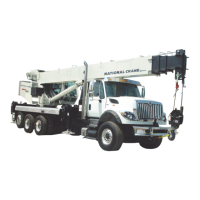
